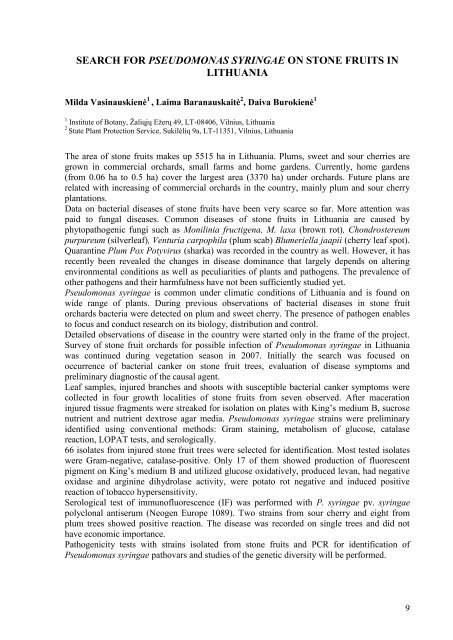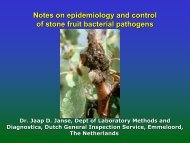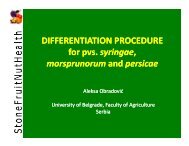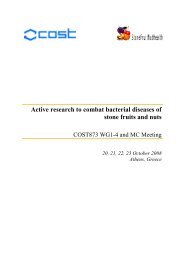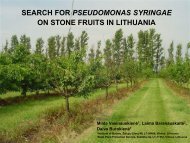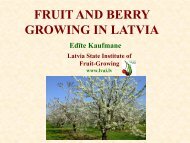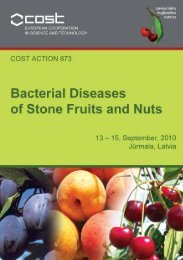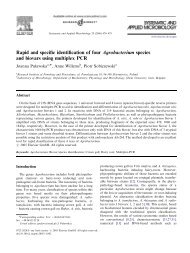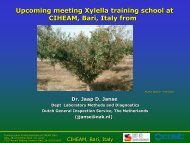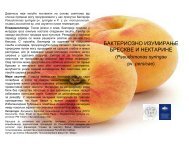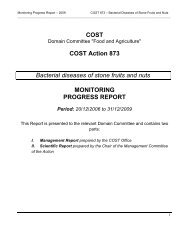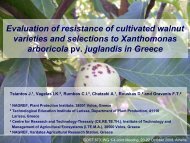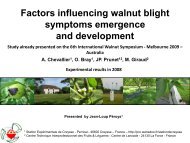Pseudomonas meeting - Cost 873
Pseudomonas meeting - Cost 873
Pseudomonas meeting - Cost 873
- No tags were found...
Create successful ePaper yourself
Turn your PDF publications into a flip-book with our unique Google optimized e-Paper software.
SEARCH FOR PSEUDOMONAS SYRINGAE ON STONE FRUITS INLITHUANIAMilda Vasinauskienė 1 , Laima Baranauskaitė 2 , Daiva Burokienė 11 Institute of Botany, Žaliųjų Ežerų 49, LT-08406, Vilnius, Lithuania2State Plant Protection Service, Sukilėlių 9a, LT-11351, Vilnius, LithuaniaThe area of stone fruits makes up 5515 ha in Lithuania. Plums, sweet and sour cherries aregrown in commercial orchards, small farms and home gardens. Currently, home gardens(from 0.06 ha to 0.5 ha) cover the largest area (3370 ha) under orchards. Future plans arerelated with increasing of commercial orchards in the country, mainly plum and sour cherryplantations.Data on bacterial diseases of stone fruits have been very scarce so far. More attention waspaid to fungal diseases. Common diseases of stone fruits in Lithuania are caused byphytopathogenic fungi such as Monilinia fructigena, M. laxa (brown rot), Chondrostereumpurpureum (silverleaf), Venturia carpophila (plum scab) Blumeriella jaapii (cherry leaf spot).Quarantine Plum Pox Potyvirus (sharka) was recorded in the country as well. However, it hasrecently been revealed the changes in disease dominance that largely depends on alteringenvironmental conditions as well as peculiarities of plants and pathogens. The prevalence ofother pathogens and their harmfulness have not been sufficiently studied yet.<strong>Pseudomonas</strong> syringae is common under climatic conditions of Lithuania and is found onwide range of plants. During previous observations of bacterial diseases in stone fruitorchards bacteria were detected on plum and sweet cherry. The presence of pathogen enablesto focus and conduct research on its biology, distribution and control.Detailed observations of disease in the country were started only in the frame of the project.Survey of stone fruit orchards for possible infection of <strong>Pseudomonas</strong> syringae in Lithuaniawas continued during vegetation season in 2007. Initially the search was focused onoccurrence of bacterial canker on stone fruit trees, evaluation of disease symptoms andpreliminary diagnostic of the causal agent.Leaf samples, injured branches and shoots with susceptible bacterial canker symptoms werecollected in four growth localities of stone fruits from seven observed. After macerationinjured tissue fragments were streaked for isolation on plates with King’s medium B, sucrosenutrient and nutrient dextrose agar media. <strong>Pseudomonas</strong> syringae strains were preliminaryidentified using conventional methods: Gram staining, metabolism of glucose, catalasereaction, LOPAT tests, and serologically.66 isolates from injured stone fruit trees were selected for identification. Most tested isolateswere Gram-negative, catalase-positive. Only 17 of them showed production of fluorescentpigment on King’s medium B and utilized glucose oxidatively, produced levan, had negativeoxidase and arginine dihydrolase activity, were potato rot negative and induced positivereaction of tobacco hypersensitivity.Serological test of immunofluorescence (IF) was performed with P. syringae pv. syringaepolyclonal antiserum (Neogen Europe 1089). Two strains from sour cherry and eight fromplum trees showed positive reaction. The disease was recorded on single trees and did nothave economic importance.Pathogenicity tests with strains isolated from stone fruits and PCR for identification of<strong>Pseudomonas</strong> syringae pathovars and studies of the genetic diversity will be performed.9


